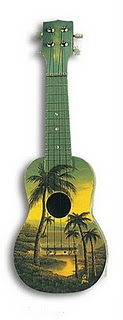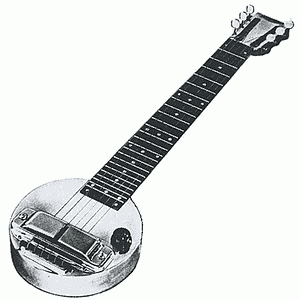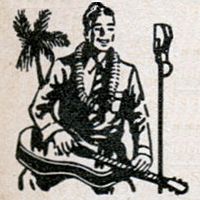Steel Guitar Harmonics
Playing Harmonics
 Jerry Byrd taught that harmonics
say, “I have a secret!” Harmonics are
beautiful. Most steel guitarists avoid playing harmonics because they scare
themselves, thinking they can't do it; but if you'll think ahead just a
little bit while you're playing, then you can play accurate harmonics. The
trick is to make sure your right palm is directly over the proper fret
(usually 12-frets higher than where the bar is resting). You can also play
harmonics by placing the palm (or a finger) 5 or 7 frets higher than the rot
bar position. There are known as ARTIFICIAL harmonics.
Jerry Byrd taught that harmonics
say, “I have a secret!” Harmonics are
beautiful. Most steel guitarists avoid playing harmonics because they scare
themselves, thinking they can't do it; but if you'll think ahead just a
little bit while you're playing, then you can play accurate harmonics. The
trick is to make sure your right palm is directly over the proper fret
(usually 12-frets higher than where the bar is resting). You can also play
harmonics by placing the palm (or a finger) 5 or 7 frets higher than the rot
bar position. There are known as ARTIFICIAL harmonics.
NATURAL harmonics
occur only with the strings open, at the 5th, 7th and 12-frets (and also at
the 17th, 19th and 24th frets). Natural harmonics work great in the song,
WHEN THEY RING THOSE GOLDEN BELLS. On the E9th pedal steel, I play a verse and chorus once
through in the key of Eb and then modulate up to the key of E, which allows
me to play the harmony using natural harmonics.
On the C6th lap steel, songs such
as KEWALO CHIMES are composed entirely of natural harmonics.
You can here this song on Jerry Byrd's album, HAWAIIAN SUNSET. Here's
a short clip of KEWALO CHIMES
(MP3). These are all natural harmonics played by using the pinky
finger of the left hand on frets 5,7 and 12. The song is not difficult to
play, it just requires patience to learn the song. The trick to playing good
natural harmonics is to pick the strings closer to the bridge for frets 7
and 5 (especially fret 5 natural harmonics). The same is true of frets 19
and 17 (especially fret 17).
I've heard that harmonics are harder on the Fender guitars,
but I've never had a Fender. I have a 1936 Rickenbacher (also called
“Rickys”) and the sustain
is MUCH longer than on my $79 Artisan lapsteel I had started learning on. I
couldn't believe the difference. If you've never played a Rickenbacher (pre
WWII models are spelled with an h; whereas post WWII Rickys are spelled
with a k... "Rickenbacker"), then you have a treat
awaiting you my friend if you ever have the opportunity to play one. On the
Rickys, the tone is
incredible due to the horseshoe pickups and the dense Bakelite body; but stay away from any guitars that
have had the volume and/or tone pot swapped out. It ruins the sound
completely and there's nothing you can do about it except to find old spare
parts... good luck!
I recently bought a great used S-8
lap steel that was built with gorgeous canary wood from South America. The
guitar has a Jerry Wallace pole pickup in it, and the sustain is some of the
best I've heard. It's awesome. You can hear me attempting to play some of
Jerry Byrd's awesome harmonics from the terrific song...
SONG OF THE ISLANDS!
A lot of students of the steel
guitar become quickly frustrated when they go to tackle harmonics, and get
tackled instead, buried upon a pile of missed notes. They think at that
point that harmonics is too difficult to learn, and will require too much
work, so they give up on the harmonics. The problem is that they don't
understand the proper techniques of great harmonics. If they could get great
harmonics in their playing, then they'd love playing harmonic chimes and use
them extensively I assure you. Playing harmonics needs to become as natural
as breathing for the steel guitarist.
The 2 things that you need to do
is:
-
 KNOW THE MELODY THAT YOU WANT TO PLAY.
Practice in advance what you want to play with harmonics (usually the
melody line). Even if you can play great harmonics, it won't help you if
you aren't sure where to place your hand next (and that creates mental
obstacles to make you trip and stumble in your playing). That's not good
at all. So we want to become familiar enough with a song and it's
melody, so we know exactly what we want to play.
KNOW THE MELODY THAT YOU WANT TO PLAY.
Practice in advance what you want to play with harmonics (usually the
melody line). Even if you can play great harmonics, it won't help you if
you aren't sure where to place your hand next (and that creates mental
obstacles to make you trip and stumble in your playing). That's not good
at all. So we want to become familiar enough with a song and it's
melody, so we know exactly what we want to play.
-
PICK THE STRING EXACTLY
OVER THE FRET. It helps to keep the right picking hand as
perpendicular to the strings as possible. Since your hand is curved,
it's easy to pick off the fret and miss the mark. You must
place the palm of your right hand over the fret to be chimed. Being off
even a little bit will result in either a missed chime altogether, or no
sustain because you struck the string TOO HARD. Gentle is better when
picking chimes. You don't want
to pick too hard, but just hard enough to get a nice chime (and
then raise up the volume pedal to make the best of your chimed note
while it rings out it's life). This is equally important. Finger chimes
are a bit easier, because you can see what's going on under your palm. So it's easy to be off by a fret
when using palm harmonics, especially higher up
on the fretboard. Practice makes perfect.
I much prefer the warmth of palm harmonics instead of finger harmonics.
Finger harmonics are brighter, thinner and have a more crisp sound. I
generally use finger harmonics in areas of a song where I tend to miss
the mark while using Palm harmonics (or of course, natural (or open
fret) harmonics). The reason why palm harmonics might fail could be the
speed of the song, an awkward chord-progression, or just how you feel
bodily and/or emotionally at the moment. If you want to hit the note
sure fire and not risk missing it, then use finger harmonics because
they are the easiest, giving you excellent view of the area. Lam
harmonics by their nature make it more difficult because you cannot see
through your hand. Still, I
I used to have a hard time with
harmonics, because I didn't have my palm exactly over the note that I had
chimed. It's much easier to place your hand accurately when you know in
advance exactly where and when to put it down on a particular fret. This is
the reason why point number 1 is so important above. If you know your song,
then you won't waste those critical milliseconds in panic trying to find the
correct place to put your hand.
Of course, seasoned musicians who
know their instruments inside and out, backward and forward, can play adlib on
a dime and execute superb harmonics nearly all the time. I'm still working
at it. I don't claim to be an expert on harmonics, but Jerry Byrd certainly
was. I learned from Jerry to THINK AHEAD a little bit in the song, to
anticipate and plan your chimes.
Here's BALI HAI, in which I play
some nice harmonics. They're not hard to do; it just takes work to get them
right. It's easy to chime a note; but it's harder when you're chiming a
melody line. I knew exactly where I was going start my first note, and made
sure to place my right palm exactly over the 10th fret where I begin at 1:29
in the video...
There a few different ways of
using harmonics that I am familiar with:
-
 multiple string
palm harmonics
(you quickly, but gently, rake across the strings 12-frets above the
bar, while simultaneously placing your left palm on the strings. It's
done better if faster and without too much effort. It is important that
you place your left hand exactly on the fret, but 12-frets higher.
Here's some palm harmonics
with the bar on the 5th fret, and then your palm chimes across the strings on
the 17th fret an octave higher, then slide up to the 17th fret with a
little vibrato at the end. You can also
chime
two notes at once (see intro) with the thumb pick, making sure your
right palm is gently lifted off the strings 12 frets higher.)
multiple string
palm harmonics
(you quickly, but gently, rake across the strings 12-frets above the
bar, while simultaneously placing your left palm on the strings. It's
done better if faster and without too much effort. It is important that
you place your left hand exactly on the fret, but 12-frets higher.
Here's some palm harmonics
with the bar on the 5th fret, and then your palm chimes across the strings on
the 17th fret an octave higher, then slide up to the 17th fret with a
little vibrato at the end. You can also
chime
two notes at once (see intro) with the thumb pick, making sure your
right palm is gently lifted off the strings 12 frets higher.)
-
single string palm
harmonics (these harmonics are played the same, but just one string
is picked. Palm harmonics are the most popular technique. I have learned
that the key to good harmonics is to LOOK with your eyes where you're
about to place your left hand, to make sure that you are on the correct
fret. If you're off even one fret, you won't get a clean harmonic. This
means listening to the rhythm track or song as you play, and
anticipating the next move. You can compensate slightly for being off
mark by using vibrato, which gives you a little leeway. I've noticed
that Jerry Byrd often uses vibrato at the end of a harmonic slide. In
other words, if you chime a note and then slide a few frets, or an
octave, using vibrato enhances your sound considerably.)
-
finger harmonics (again, 12 frets higher, but you simply touch one of your left hand's
fingers on the string, while gently picking the string. I usually use
the backside of my 3rd finger, i.e., the finger next to the pinky.)
-
open string harmonics
(These are commonly called “chimes.” You can use your pinky finger to
chime harmonics on the 5th, 7th, 12th, 17th, 19th, and 24th frets. In fact,
you can play an entire song, like Maui Chimes. It's more
difficult to play chimes on the 7th, and even more hard on the 5th fret.
The trick is to pick closer to the pickup when playing harmonics on the
7th and 5th frets. It's much easier then. Also, a gentler touch will produce better
harmonics).
-
Testing guitar intonation
(harmonics are a great way of testing your guitar's intonation, i.e.,
the distance between the nut and the bridge. The 12th fret is the
half-way mark between the nut and the bridge. If intonation is set
properly, then the 12th fret harmonic should be exactly one octave above
the open string note. If playing a harmonic at the 12th fret produces a
higher note than the string picked open, then you need to adjust the
intonation, moving toward the bridge a little bit; thus lengthening the
guitar string. Adjust each string this way.)
-
Split Harmonics (Jerry
Byrd plays one string chimed and the other unchimed. It sounds
beautiful. It requires careful maneuvering of the hand and fingers. Very
few players use this technique. The secret is to chime the low note and
leave the high one unchimed. It would be extremely difficult to do it
the other way. The technique is quite easy once you learn it. It's very
difficult to do strings right next to each other, but it's easy to do
split harmonics with 1 or 2 strings in between. For example: If you
follow the scales, you would playing
the following using split harmonics. Only the bottom note is chimed
using the right palm, which I signified with a * symbol.)
E_______3___5___6___8___10___12___13___15___17________________________________
C___5____________________________________________17___________________________
A______________*5__*7____________*12__________________________________________
G______*3__*5__________*10__*12_______*15__*17________________________________
E__*5___________________________________________*17___________________________
C#____________________________________________________________________________

Adding some harmonics
every-so-often is an important part of playing any slower steel guitar song,
which adds a personal touch. Listen to this wonderful recording by John W.
Peterson playing
THEN I MET THE SAVIOUR. You can hear him play a palm harmonic note
several times throughout the song. Follow your heart and ears and you'll
feel where to play harmonics. Palm harmonics sound best in my opinion.
Finger harmonics are brighter, but have less substance to the chime.
After awhile playing harmonics will become natural and
you'll know exactly when to play them, as your ears will tell you. Most
players avoid harmonics because they are challenging at first to learn, but
I guarantee you that you'll be so glad you kept at it once you get
proficient at them. No matter how bad you are at picking harmonics, keep at
it. Make sure that you're right hand is not curled up; but rather, more
straight across the fret. It's won't be perfectly straight, but straight
enough. If you're having trouble getting good harmonics, try to straighten
your right picking hand a bit when you go to chime. You'd be surprised how
just re-adjusting your picking hand can make a big difference.
The bottom line is that if you're not obtaining
good harmonics, you're doing something incorrectly. Once you identify what
it is, you'll be playing nice harmonics. Study your playing until it is what
you want it to be. When my harmonics seem to be dropping off, it's usually
because I'm not straightening my right hand enough across the fret. The
hand's muscles and tendons cause the hand to naturally curl, which makes for
poor palm harmonics.
What really got me into palm harmonics was
listening to myself play on a video recording that I made. When I heard how
nice the harmonics sounded when I played a few, I realized that I should be
playing harmonics on a regular basis. Record yourself, play some harmonics,
and you'll see what I mean.
Like Tony The Tiger (remember that old
TV cereal commercial) says, "THEY'RRREEE GREAT!" Keep at it, you can do it!
~By David J. Stewart

Above: Rogue Lap Steel with Aluminum Nut.
There's a coconut palm tree painted on my neck. I took a photo of the
guitar and then used an effect in my Microsoft Photo Editor
program called "Edge" to give it a drawing look. Pretty neat!
C6th Scales | C6th Chords |
C6th Tabs
Take someone to the islands today with your
music!

Kindly, if all you have is music, you have nothing!
You need Jesus Christ as your personal Savior to truly
be prosperous in life. You may be the poorest man in the world
materialistically, but if you have received Jesus as the Christ, the Son of God;
believing on His name to forgive your sins, then you are a rich soul indeed!

John 20:31, “But
these are written, that ye might believe that Jesus is the Christ, the
Son of God; and that believing ye might have life through his name.”

 Jerry Byrd taught that harmonics
say, “I have a secret!” Harmonics are
beautiful. Most steel guitarists avoid playing harmonics because they scare
themselves, thinking they can't do it; but if you'll think ahead just a
little bit while you're playing, then you can play accurate harmonics. The
trick is to make sure your right palm is directly over the proper fret
(usually 12-frets higher than where the bar is resting). You can also play
harmonics by placing the palm (or a finger) 5 or 7 frets higher than the rot
bar position. There are known as ARTIFICIAL harmonics.
Jerry Byrd taught that harmonics
say, “I have a secret!” Harmonics are
beautiful. Most steel guitarists avoid playing harmonics because they scare
themselves, thinking they can't do it; but if you'll think ahead just a
little bit while you're playing, then you can play accurate harmonics. The
trick is to make sure your right palm is directly over the proper fret
(usually 12-frets higher than where the bar is resting). You can also play
harmonics by placing the palm (or a finger) 5 or 7 frets higher than the rot
bar position. There are known as ARTIFICIAL harmonics.
 KNOW THE MELODY THAT YOU WANT TO PLAY.
Practice in advance what you want to play with harmonics (usually the
melody line). Even if you can play great harmonics, it won't help you if
you aren't sure where to place your hand next (and that creates mental
obstacles to make you trip and stumble in your playing). That's not good
at all. So we want to become familiar enough with a song and it's
melody, so we know exactly what we want to play.
KNOW THE MELODY THAT YOU WANT TO PLAY.
Practice in advance what you want to play with harmonics (usually the
melody line). Even if you can play great harmonics, it won't help you if
you aren't sure where to place your hand next (and that creates mental
obstacles to make you trip and stumble in your playing). That's not good
at all. So we want to become familiar enough with a song and it's
melody, so we know exactly what we want to play.  multiple string
multiple string



